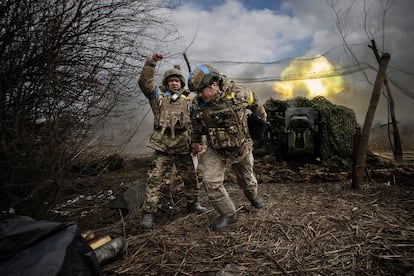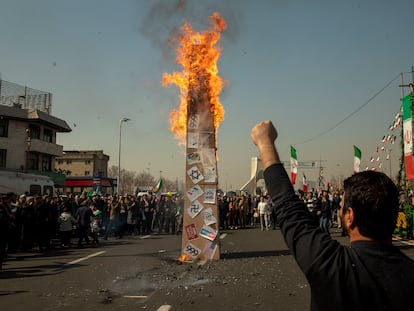Two years after Russia invaded, the war in Ukraine has stalled
Russia has taken the initiative with timid advances in the face of ammunition shortages for Kiev’s troops, lack of additional soldiers and doubts about Washington’s support. Analysts predict a long conflict

Stalemate, fatigue, attrition. The “special military operation” in Ukraine that Russian President Vladimir Putin announced on February 24, 2022, has just turned two years old, and the full-scale invasion has not yielded the results that the Kremlin was hoping for. With tens of thousands of dead and wounded, Russia’s war in Ukraine is entrenched in a front in the east and south of the country of over 497 miles (800 kilometers) of fortifications, mines and trenches in which neither side is making significant gains. Ukraine and its Western allies are beginning to show fatigue. The ammunition provided by Ukraine’s partners, without which Kyiv never would have been able to resist the world’s second largest military power, is in short supply. The U.S. Congress is blocking the White House’s new aid package for Kyiv, while the European arms industry is unable to produce at the pace needed by the Ukrainians, allowing Moscow to regain momentum.
Over the past two years, the war has had three stages. Following Moscow’s full-scale invasion, Kyiv managed to repel the aggression, forcing Putin’s troops to regroup in the east and south of the country. It then regained key territories around the city of Kharkov and towns such as Kherson. Thanks to increasingly strong military support from the West — some countries were hesitant to get involved in the conflict at first —Ukraine launched a counteroffensive last June to try to drive Russia out of occupied territory. But the new Leopard and Abrams tanks, armored vehicles, and training for troops abroad were not enough to break through the Russians’ defensive barrier in the positions they control. “As in World War I, we have reached a technological level that puts us at a stalemate,” the former commander-in-chief of the Ukrainian army, Valeri Zaluzhni, told The Economist last November.
“Right now, the war is in a stage of tactical blockage, of stalemate,” explains Thibault Fouillet of the Paris-based Foundation for Strategic Research. “For five or six months now, we have been going through a phase in which there’s no real momentum in sight. After two alternating attempts at major offensives by both sides, we find ourselves in a situation of limited war,” the military expert continues. “It is true that the Russians are now advancing, but they are doing so very slowly and moderately.” Fouillet downplays the shortage of military supplies that Kyiv complains about. “Even if the situation is critical, Ukraine is not going to find itself without any ammunition tomorrow. Globally, we are in a period of shortages, but supplies, even if they decrease, are not going to disappear. Ukraine is not going to collapse because of a lack of shells; if it collapses, it will be because of a lack of morale or fatigue,” he says. “Mind you, without enough shells, it won’t be able to launch a new offensive,” he adds.
Under these conditions, holding on to the areas under its control is all Kyiv can do for now (it controls 80% of its territory), Mykola Beleskov, an analyst at Ukraine’s National Institute for Strategic Studies, argues. “In 2024, our goal on the ground must be to retain the territories we control. We have no choice but active defense due to ammunition shortages and difficulties in mobilizing” new soldiers, he argues in an interview with the public television news channel. Like Fouillet, Beleskov admits that it is now Russia that has the momentum, “but it lacks sufficient leverage to launch a new offensive.”
With no significant progress made on either side, the conflict has become a war of attrition. In order to wage it, Ukraine will continue to need military and economic aid from its allies; there’s no rush to achieve immediate results. “The most effective way for Ukraine to regain its advantage is to build an effective and deep defense that will reduce its casualties and ammunition requirements,” argues Franz-Stefan Gady of the International Institute for Strategic Studies (IISS) in London.
This expert estimates that Kyiv will need between 75,000 and 90,000 artillery shells each month to achieve that goal. “The West must understand that Ukraine’s driving force in the war is its ability to inflict heavy attrition, causing more personal and material casualties than the enemy.” Gady emphasizes that now is not the time to advance on the ground, but rather to defend against Russian attacks and reconstitute their forces to achieve a battlefield advantage later. “Ukraine and the Western countries enjoy an overall resource advantage [over Russia], and attrition may prove important in achieving victory.”
A defensive strategy
“Last summer’s counteroffensive is what really exhausted the Ukrainians in terms of manpower and weaponry, as was the case with Russia after the invasion,” says Fouillet, the French analyst. “Now they need to resist and mobilize new troops to establish soldier rotations,” he adds. “Ukraine has to recover, find new means of combat, get new supplies from the West. That is why it is in a defensive posture. It is time to regenerate its forces and waste as little time as possible. Ukraine needs more men, more material. And that cannot be achieved overnight.” Since December, the Ukrainian Parliament has been debating a mobilization bill, the initial objective of which was to recruit 500,000 new soldiers; but the initiative has faced strong social rejection, in contrast with the massive influx of volunteers who answered the call at the beginning of the war two years ago.
While low morale is an issue, economic matters are not helping either. Last October, U.S. President Joe Biden asked Congress for $60 billion in supplementary aid for Ukraine after the funds pledged in December 2022 by its largest arms donor ran out in the second half of last year. However, the proposal is stalled for the time being amid the refusal of the Republican majority in the House of Representatives to pass it. For its part, the European Union has approved an assistance package of €144 billion, of which it has already delivered €77 billion. Of the amount actually provided by European countries as a whole, 35.2 billion corresponds to military supplies, according to the latest study by the Kiel Institute for World Economics (IFW) in Germany.
“Now, the biggest risks are not related to the front,” Beleskov emphasizes. “In the US, the main problem is the beginning of the election campaign [the November presidential election], where some actors [referring to the Republicans] evaluate aid to Ukraine not from the perspective of victory or defeat, but from the point of view of their candidate’s chances to win,” he continues. “If Ukraine does not demonstrate its willingness and readiness to resist, it will be much easier for those who oppose helping us to achieve their goals.” Like other analysts we consulted, Beleskov also notes that both the US and Europe need time to increase production of armaments and ammunition: “The years 2022 and 2023 were the period when we counted on the reserves that our partners had accumulated until 2022. Now they are depleted.”
If Western aid continues, the most globalized conflict since World War II is for the long haul, experts say. Commission President Ursula von der Leyen and the European Union’s rotating president, Belgian Prime Minister Alexander de Croo, plan to demonstrate that support with a visit to Kyiv on Saturday. “We are doing everything we can to end the war as soon as possible,” Ukrainian President Volodymir Zelensky told Fox News on Thursday. “The war will end only when the world is ready to stop Putin; but let’s be frank, the world is not ready, the world is afraid of possible changes in Russia. When the world realizes that Putin has crossed all the red lines, this war will end.”
Sign up for our weekly newsletter to get more English-language news coverage from EL PAÍS USA Edition
Tu suscripción se está usando en otro dispositivo
¿Quieres añadir otro usuario a tu suscripción?
Si continúas leyendo en este dispositivo, no se podrá leer en el otro.
FlechaTu suscripción se está usando en otro dispositivo y solo puedes acceder a EL PAÍS desde un dispositivo a la vez.
Si quieres compartir tu cuenta, cambia tu suscripción a la modalidad Premium, así podrás añadir otro usuario. Cada uno accederá con su propia cuenta de email, lo que os permitirá personalizar vuestra experiencia en EL PAÍS.
¿Tienes una suscripción de empresa? Accede aquí para contratar más cuentas.
En el caso de no saber quién está usando tu cuenta, te recomendamos cambiar tu contraseña aquí.
Si decides continuar compartiendo tu cuenta, este mensaje se mostrará en tu dispositivo y en el de la otra persona que está usando tu cuenta de forma indefinida, afectando a tu experiencia de lectura. Puedes consultar aquí los términos y condiciones de la suscripción digital.
More information
Archived In
Últimas noticias
Most viewed
- Sinaloa Cartel war is taking its toll on Los Chapitos
- Oona Chaplin: ‘I told James Cameron that I was living in a treehouse and starting a permaculture project with a friend’
- Reinhard Genzel, Nobel laureate in physics: ‘One-minute videos will never give you the truth’
- Why the price of coffee has skyrocketed: from Brazilian plantations to specialty coffee houses
- Silver prices are going crazy: This is what’s fueling the rally









































